Updated: 23 August 2025
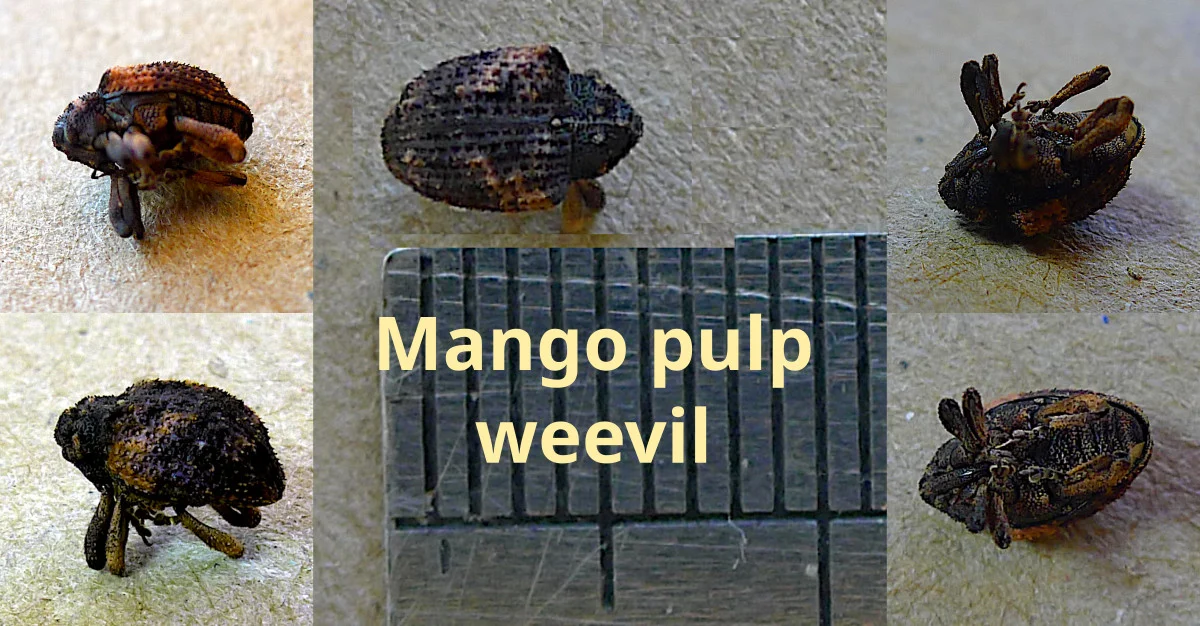
The mango pulp weevil (MPW) (Sternochetus frigidus) is a small but destructive pest that attacks mangoes. This pest has become a major concern to mango farmers in Palawan, Philippines. First recorded in 1987, this weevil continues to prevent local farmers from exporting mangoes to international markets. Thus, measures were undertaken to gain control over the damaging impacts of this persisting problem.
In this article, you’ll learn about the weevil’s morphology, behavior, control measures, and its economic impact, including a hypothesis on how mango sap acidity may naturally defend against infestation.
Table of Contents
- What is the Mango Pulp Weevil?
- Morphology of the Mango Pulp Weevil
- Behavior of the Mango Pulp Weevil
- Preventive Measures Against Mango Pulp Weevil
- Is Banning Mango Export the Answer?
- Mango Sap Hypothesis: A Natural Defense?
- Categories of Mangoes from Field Observation
- Conclusion
- Frequently Asked Questions (FAQ)
- References
What is the Mango Pulp Weevil?
Unlike other mango pests that target the skin or seed, the mango pulp weevil invades the edible flesh of the fruit. Females lay eggs inside the pulp, and larvae feed on it, creating tunnels that reduce fruit quality. This hidden damage makes the fruit unsuitable for export.
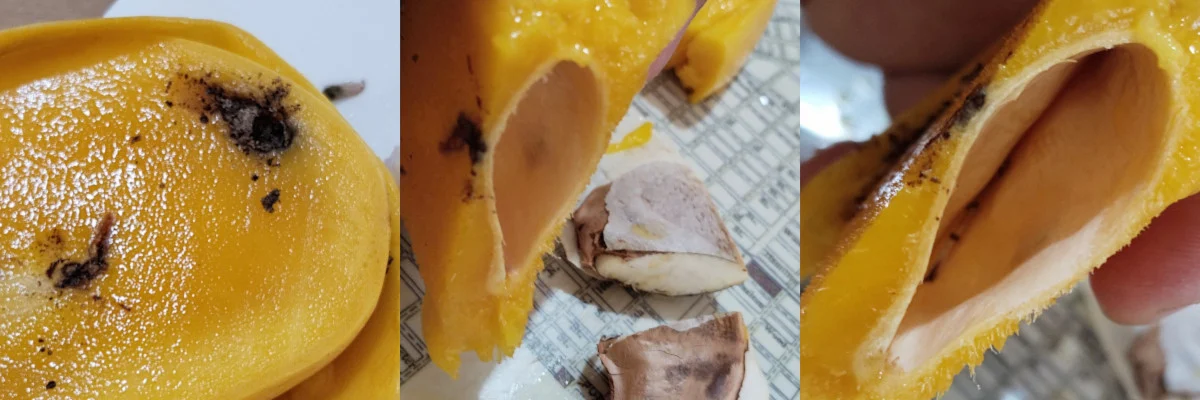
For more than two decades, Palawan mango growers have faced export restrictions, as the pest could spread to other mango-producing regions. The economic losses are severe, with some farmers losing as much as 30% of their harvest.
Morphology of the Mango Pulp Weevil
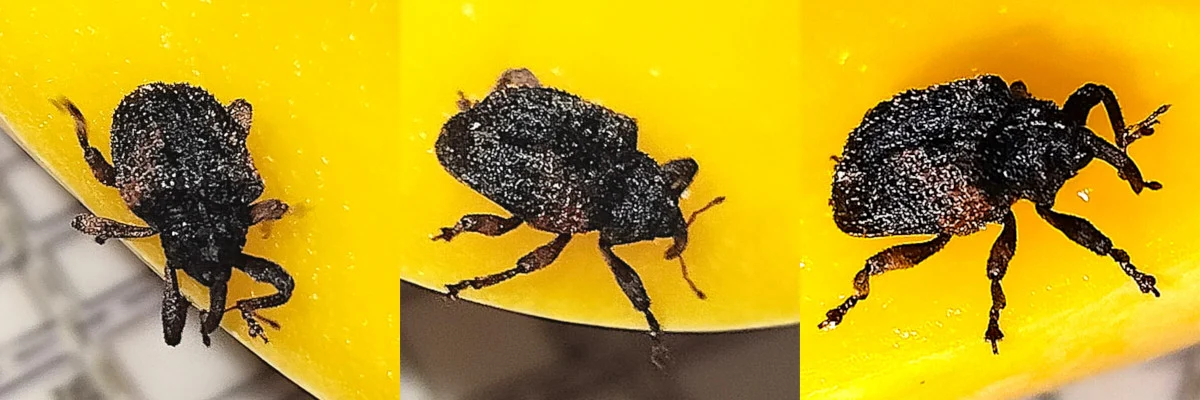
- Size: Around 6 mm long and 4 mm wide.
- Coloration: Brown underside with an orange dorsal region, mottled with black bands.
- Wings: Pitted and covered with rough keratinous projections that may help in burrowing.
- Snout: Long, with antennae ending in rounded tips.
See the video demonstration of how fast the weevil moves once it emerges from the mango pulp.Two mango weevils escape from the mango pulp upon slicing a ripe fruit.
Behavior of the Mango Pulp Weevil
- Found inside the mango pulp, usually close to the seed.
- Can remain in diapause (suspended animation) until the next fruiting season.
- Typically stay near the parent tree; they do not fly far.
Consumers can still eat unaffected portions, or process infested fruit into dried mangoes.
Preventive Measures Against Mango Pulp Weevil
Based on field observations and studies, the following control methods are recommended:
- Remove and destroy infested fruits – bury them at least 0.5 m deep.
- Bagging mangoes with newspapers or protective material to prevent infestation.
- Harvest at maturity – do not wait until the mango is overripe.
- Natural predators – explore the use of weaver ants such as Oecophylla smaragdina, which feed on weevils.
- Report illegal mango shipments from infested areas.
- Post-harvest treatments – irradiation is currently the most cost-effective quarantine method compared to heat treatment or fumigation (Follet, 2001) or cold treatment (see a comparison of the different quarantine measures in the matrix below).
| Treatment | Energy Requirement | Fruit Quality Impact | Environmental / Health Impact | Cost Considerations | Effectiveness Against Mango Weevils |
|---|---|---|---|---|---|
| Irradiation (100–400 Gy) | Low – Cobalt-60 requires minimal energy; e-beam uses moderate electricity | Minimal (does not heat fruit; maintains taste, texture, and nutrients) | No toxic residues; safe for consumers | High upfront facility cost, but low operational cost | Sterilizes weevils at 100 Gy; effective at preventing reproduction |
| Hot Water Treatment / Vapor Heat | High – requires heating large volumes of water/air for long durations | Can cause skin scalding, uneven ripening, or reduced shelf life | No chemical residues, but high energy use | Lower infrastructure cost than irradiation, but higher recurring energy costs | Partially effective; not always reliable for internal pests like pulp weevils |
| Chemical Fumigation (e.g., methyl bromide) | Moderate – depends on fumigation chamber operations | Can affect flavor and shelf life | Produces toxic residues; ozone-depleting (methyl bromide is being phased out globally) | Moderate setup cost; chemical supply is ongoing expense | Historically used, but effectiveness is inconsistent for deeply embedded weevils |
| Cold Treatment | High – requires weeks of refrigeration at very low temps | Can damage tropical fruit (chilling injury in mango) | No residues, but high electricity demand | Costly due to long storage time | Not effective for mango weevils; used mainly for fruit flies |
Is Banning Mango Export the Answer?
Banning mango exports from Palawan has prevented the spread of the pest but caused significant economic loss. For example:
- Palawan mango production dropped by 30% after the ban.
- Household-level studies showed only 3% infestation rates in some locations, raising questions about whether a total ban is justified.
Instead of banning, experts suggest:
Quarantine treatments
Quarantine treatments for export mangoes can help mango growers. The study by Glenda Obra and colleagues (2013) investigated the potential of irradiation as a quarantine treatment for the mango pulp weevil (Sternochetus frigidus), using mangoes naturally infested with weevils collected from Palawan. Researchers irradiated different life stages (larvae, pupae, and adults) at doses ranging from 25 to 400 Gy. At doses above 75 Gy, adults emerging from irradiated larvae and pupae were completely sterile. For adult weevils, sterility was achieved at 100 Gy, confirming this as the most effective minimum dose. The procedure is more efficient than other means of quarantine.
Value-adding strategies
Selling dried mangoes can give economic value to otherwise discarding mangoes including uninfected ones. Slicing the pulp would reveal uninfected fruits which composes the majority of mango production.
Localized monitoring
Monitoring of actual infestation levels should periodically minimize the incidence of mango pulp weevil infestation. Island to island transfer of mango produce should be closely monitored and managed in the province of Palawan to avoid the continued dispersion of adult mango pulp weevil.
(Note: The author bought four mangoes sold by a vendor along the road. Those mangoes originated from Dumaran Island. One of these four is infected with MPW; shown in the pictures and prompted the writing of this update).
Mango Sap Hypothesis: A Natural Defense?
Recent observations suggest that mango sap acidity may naturally defend against the mango pulp weevil.
- During harvest, highly acidic sap caused skin burns upon contact, showing strong chemical properties.
- Hypothesis: The acidic sap may damage or kill eggs/larvae inside the fruit, reducing infestation.
- This aligns with plant defense mechanisms, where species produce alkaloids, saponins, and resins to repel pests (Ryan, 1990).
Further research is needed, but this finding could lead to eco-friendly pest management strategies.
Categories of Mangoes from Field Observation
I did a simple assessment of mature mango fruits harvested from trees growing within our yard on May 2014. From a batch of 50 harvested mangoes, I got the following statistics:
- 48 mangoes – uninfected
- 0 mangoes – infected with mango pulp weevil
- 2 mangoes – infected with other diseases (mango rot)

This finding supports the idea that natural plant defenses may play a role in reducing infestation (War et al., 2028). I noticed that the mango sap can easily burn my skin unlike before. Apparently, the sap has become more acidic. Also, the taste of mango has changed somehow. This observation requires further study to test the hypothesis that the mango sap in Palawan is more acidic than other mangoes in the Philippines as a natural response to pest infestation.

Conclusion
The mango pulp weevil continues to threaten mango production in Palawan and the Philippines in general. While current strategies like irradiation and field sanitation help, a long-term, sustainable farming practices that address this problem is still needed. Research into natural plant defenses, such as acidic sap, may offer a breakthrough for both farmers and the mango industry.
Until then, careful pest management, strict quarantine measures, and exploring alternative markets for mango products remain the best approach.
Frequently Asked Questions (FAQ)
1. What is the mango pulp weevil?
The mango pulp weevil (Sternochetus frigidus) is a pest that lays eggs inside mango flesh, where larvae feed and cause hidden damage.
2. How can farmers control mango pulp weevil?
Best methods include removing infested fruits, bagging mangoes, early harvest, using natural predators, and applying post-harvest treatments like irradiation.
3. Why is mango export from Palawan banned?
To prevent the spread of the pest to other mango-producing regions, which could endanger the global mango industry.
4. Can humans eat infested mangoes?
Yes, unaffected parts can be consumed, or fruits can be processed into dried mangoes, but infested pulp is usually discarded.
5. Can mangoes naturally resist the weevil?
Some evidence suggests acidic sap may play a role in preventing infestation, but more research is needed.
References
Catindig, J. L. A. and K. L. Heong, 2005. Description of mango pulp weevil. Retrieved on May 27, 2014 from http://www.niaes.affrc.go.jp/techdoc/apasd/Sternochetus%20frigidus%20-B.html
De Jesus, L. R. A., Calumpang, S. M. F., Medina, J. R., & Ohsawa, K. (2004). Influence of mango chemicals on the mango pulp weevil, Sternochetus frigidus (fabr.). Philippine Entomologist, 18(2).
Follett, P. A. (2001). Irradiation as a quarantine treatment for mango seed weevil. Proc. Hawaiian Entomol. Soc. (35:85–90). Retrieved on August 23, 2025 from https://scholarspace.manoa.hawaii.edu/server/api/core/bitstreams/f73e3534-d79f-4f8a-8709-614c1f833cdf/content
Gove, T.; Joubert; J. P.; and M. S. de Beer; 2007. Literature review on mango seed weevil Sternochetus mangiferae (Fabricius) (Coleoptera: Curculionidae). SA Mango Growers’ Association Research Journal 27:21-28.
RenKang, P. and K. Christian, 2007. The effect of the weaver ant, Oecophylla smaragdina (Hymenoptera: Formicidae), on the mango seed weevil, Sternochetus mangiferae (Coleoptera: Curculionidae), in mango orchards in the Northern Territory of Australia. International Journal of Pest Management, 53(1):15-24.
Ryan, C. A. (1990). Protease inhibitors in plants: genes for improving defenses against insects and pathogens. Annual Review of Phytopathology, 28(1), 425-449.
Balock, J. W., & Kozuma, T. T. (1964). Notes on the biology and economic importance of the mango seed weevil, Sternochetus mangiferae (Fabricius), in Hawaii (Coleoptera: Curculionidae). Proceedings of the Hawaiian Entomological Society, 18, 353–364.
Follett, P. A. (2001). Irradiation as a quarantine treatment for mango seed weevil (Coleoptera: Curculionidae). Proceedings of the Hawaiian Entomological Society, 35, 95–100.
Follett, P. A. (2009). Generic radiation quarantine treatments: The next steps. Journal of Economic Entomology, 102(4), 1399–1406. https://doi.org/10.1603/029.102.0401
Hallman, G. J. (2000). Expanding irradiation quarantine treatments beyond fruit flies. Agricultural and Forest Entomology, 2(2), 85–95. https://doi.org/10.1046/j.1461-9563.2000.00053.x
Hallman, G. J. (2011). Phytosanitary applications of irradiation. Comprehensive Reviews in Food Science and Food Safety, 10(2), 143–151. https://doi.org/10.1111/j.1541-4337.2010.00142.x
Hallman, G. J., Levang-Brilz, N. M., Zettler, J. L., & Winborne, I. C. (2010). Factors affecting ionizing radiation phytosanitary treatments and implications for research and generic treatments. Journal of Economic Entomology, 103(6), 1950–1963. https://doi.org/10.1603/EC10228
Obra, G. B., Resilva, S. S., & Lorenzana, L. R. J. (2013). Irradiation as a potential phytosanitary treatment for the mango pulp weevil Sternochetus frigidus (Fabr.) (Coleoptera: Curculionidae) in Philippine super mango. The Philippine Agricultural Scientist, 96(2), 172–178.
Seo, S. T., Kobayashi, R. M., Chambers, D. L., Steiner, L. F., Lee, C. Y. L., & Komura, M. (1974). Mango seed weevil: Cobalt-60 gamma irradiation of packaged mangoes. Journal of Economic Entomology, 67(4), 504–505. https://doi.org/10.1093/jee/67.4.504
War, A. R., Taggar, G. K., Hussain, B., Taggar, M. S., Nair, R. M., & Sharma, H. C. (2018). Plant defence against herbivory and insect adaptations. AoB plants, 10(4), ply037.
World Health Organization. (1994). Safety and nutritional adequacy of irradiated food. Geneva: WHO.



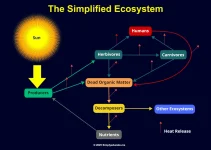
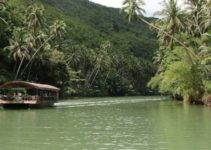
When people get baffled by unexplained events or circumstances that may or may not be related to their proximity to balete, this further reinforces their belief.